When I was asked to hold this lecture I felt very honoured. But as the date drew nearer I became a bit nervous. What should I talk about and how long for? Is my English still good enough after all those years away? After all, I have only been speaking English on rare occasions since my return to Holland in 1980. My English has become a bit rusty. And when I lecture I like to improvise. I dislike paper and pictures. And anyway – I have hardly any pictures of Dixter from when I worked here. I did not even have a camera. In those days it was not the custom to record everything visiually. Although Christo sometimes photographed plants or gardens. He needed pictures for his lectures with his ancient magic lantern. But I was always relieved to see that photography was one thing he was not brillant at.
I also dislike the use of beamers. I think a beamer is all too often a lifebuoy for those who have nothing to say. Although honesty commands me to confess that I often use the wretched thing myself. But on rare occasions, like this one, I have the chance to do without.
So no pictures, I decided, but what subject should I talk upon? I could talk about gardens in Holland, or about new developments in the breeding of Clematis. Perhaps about all the new plants which have recently flooded in from China. But should not a Christopher Lloyd Memorial Lecture have something to do with Christopher Lloyd? Or with Dixter? And after all - am I not one of the last surviving mastodonts who worked with Christo more than 40 years ago? Soon all information will be hearsay.
So let me speak about the garden and about the man himself and about the way they both changed over the years, now that I still have most of my faculties. I am not comparing myself to Obama, but my subject will be change. If you want to hear about the latest gardening developments in Holland, send me an email.
When I talk without a written script I tend to think a lot. And while thinking, I make a not so pleasant sound. I go eh…eh. There is no joy in that for the listener. Unless after each thinking pause I come up with a veritable pearl of wisdom. But that is difficult, especially in a language which is not ones mothertongue. In the future no doubt you’ll all have a translation app on your smartphone and then I’ll be able to talk in Dutch. For now I have had to make a concession and I made a script. I will read this lecture from paper, to my own frustration, but to protect you from my eh eh thinking noises. I hope you don’t mind.
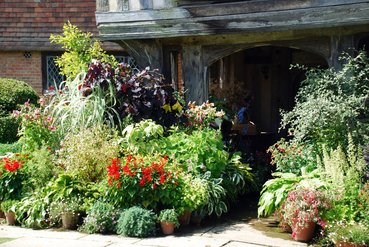
When I return to Dixter, as I do nearly every year, the students and volunteers who work at Dixter often ask me whether I think the place has changed. The answer is yes, it certainly has. I first arrived at Great Dixter in June 1976. It was hot weather and it was my 31st birthday. That is more than 40 years ago now. It is not surprising that everything has changed since then. In 1976 there was no internet, there were no mobile phones. There had been no Margaret Thatcher. Harold Wilson was Prime Minister then. The postman used to leave his letters under a big stone on the chest in the porch (as seen above) and the milkman put his milkbottles in the backyard, by the kitchen door. Hop gardens surrounded the village and sea trout came up the river Rother. Northiam had four pubs, a hotel, a bank, a post office and countless shops. Since then the village and the rest of the world have changed beyond recognition.
The gardening world has changed as well. England and continental Europe were hit by the Dutch Wave, a naturalistic style of gardening, often resulting in a rather shapeless mass of grasses, Sanguisorbas, Echinaceas and other perennials. There was an influx of new plants – not just from China, but also from America - and gardening for wildlife became increasingly popular. In the 1970’s the countryside was relatively unspoilt, although the rot set in much earlier. And as farming became more industrialized, wildlife fled to gardens and now gardeners are trying to recreate within their gardens what has disappeared forever outside the garden fence.
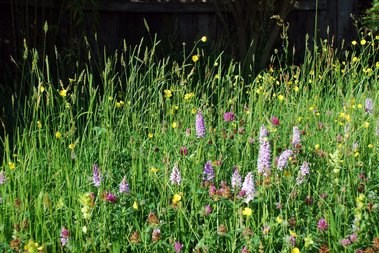
But herbicides and insecticides were not yet frowned upon in those early days. DDT was already forbidden but Christo had hoarded the stuff, and prided hinself on having enough DDT tot last him a lifetime. The mole catcher came round regularly with a supply of earthworms, cut in half and dipped in strychnine. Moles were not caught but poisoned in those days and no one thought anything of it.
Clematis in the nursery were watered with a strong solution of formaldehyde to kill the worms in the pots so that they could not block the drainage holes. Benomyl, a fungicide, was not only used in the nursery agains Clematis wilt, but widely in the rest of the garden. Christo was a man of his time and he prided himself on being a countryman. He was very interested in wildlife, he loved and knew his birds and his butterfies, but he also shot the rabbits in the nursery early in the morning from his bathroom window, sometimes just missing me as I stepped out of my front door. His dachshunds regularly made a meal of newborn rabbits, of which there were lots in the garden, and sometimes they did so in view of the garden visitors. Anyone who did not like the sight was labelled as soft. Before my time Christo allowed fox hunting on the Dixter estate, but after the foxhounds had charged through his Long border, he forbade them to cross the bounderies. There was a lot of biodiversty at Dixter, but the word did not yet exist. And if it had, I doubt whether Christo would have used it. He would have thought of a more original word. I have not made a search recently, but I am sure there is no DDT left at Dixter, unless perhaps in the archive. Times have changed. In 1976 Dixters meadows were unique.
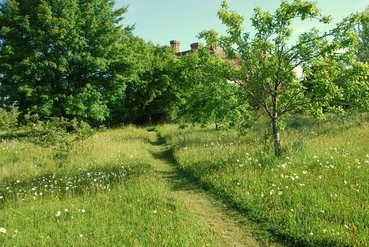
Now a meadow has almost become a cliche and no fashionable garden dares to be without one.
Not only gardens and views have changed; the same can be said of people and thus also of Christopher Lloyd. I would be exagerating if I said he changed beyond recognition as the years progressed, but the Christopher of 1976 evolved quite a bit in the 30 years I knew him. I first met him about a month before I started working at Dixter. The meeting happened by chance. I had never heard of Christopher Lloyd, nor of Great Dixter. It was in the time when big breweries forced the smaller ones out of the beer market and when people started drinking lager instead of best bitter or mild ale. A movement started up, in defence of real British ale. It was called CAMRA, short for Campain For Real Ale. I was working at Wisley Gardens at the time and a friend who was a trainee at Wisley was a supporter of CAMRA. Charley – that was his name – always proudly wore his CAMRA T-shirt to work.
His sister happened to live in Northiam, right at the bottom of Dixter lane. Charley had heard that there was a pub in Northiam, The Six Bells on the village green, which sold marvellous real ale. Would I like to come along? I have never been much of a beer drinker; I prefer cider, but the Six Bells also sold a good strong local cider: Bob Luck’s Special Vintage. In those days the pubs were open at lunchtime, but turfed everyone out at half past two, to reopen at six. We had a jolly good time at lunchtime, but that left us 31/2 hours to fill till reopening. Fortunately Charley remembered that there should be a famous garden in Northiam somewhere, and slightly inebriated we ended up at Dixter. We got talking to a man who was weeding on his hands and knees in the high garden, two dachhunds were dozing on his old tweed jacket. (Crocus and Sweety Pie the 2nd, I was te learn later).
He proved to be the owner of the garden. After a lively conversation he got out his notebook and asked us for our names and adresses. A few days later I received a letter from Mr. Lloyd. Don Moffatt, his head-gardener was retiring and would I perhaps like to take his place? I enquired amongst my friends about this Lloyd. Not many had heard of him, but one, Ursula Buchan, knew that he had written a book on Clematis. I went to the Wisley Library and borrowed it. And never returned it, I’m ashamed to confess. Here it is, the stamp of the Royal Horticultural Society a bit faded on the first page. 45 shillings net., I owe the RHS. Unless they want interest. On the back there is a photograph of young Christopher wearing a tie and jacket and admiring the flowers of Clematis ‘Lasurstern’, growing against the shed in the topiary garden.
Until then, I had always thought that a monograph would by definition be boring. But Christo proved me wrong. Allow me to quote the beginning sentences of the first chapter of his Clematis book.
‘If we ask ourselves why a plant is popular, we are liable to find that it is for reasons of which we cannot fully approve. Why, for instance, is Forsythia x intermedia ‘Spectabilis’ ubiquitous? Obviously because it carries more bright yellow per cubic inch (and not a leaf to dilute the effect) than any other shrub then flowering. A few weeks later, the double pink cherry, Kanzan, will perform the same kind office, while in July there will be thousands of porches up and down the country loaded with lumps of solid purple which is Clematis x jackmanii. The fastidious gardener shudders in the face of such repetitious vulgarity. But he would be an aneamic kind of prig if his squeamishness led him to veto the entire race of large-flowered Clematis hybrids on the same grounds. Colour in quantity is only objectionable if slapped on with an undiscriminating disregard for texture and form. The fundamental beauty of the finest clematis rests on the exquisite structure of their blooms. No matter how often they are repeated, their individuality will be retained.
Taking the variety ‘Lasurstern’ as an example: each bloom, at the plants first flowering in May and June, has a 6- to 7-inch span. And there are seven to eight sepals, which broadly overlap towards the centre of the flower, thus giving it a firm, strong axis. Gradually these radiating sepals taper to very fine points while their margins gently undulate in seductive ripples. The colour is dissatisfying only when we try to describe it, for neither ‘blue’ nor ‘mauve’ will do: it is somewhere in between, intense and deep at the flowers first opening, gradually fading to a typical campanula shade. A cushion of prominent stamens in creamy-white form a distinctive focal ‘eye’. On a well-trained plant, more than 200 of these blooms will be repeated over an area 15 feet wide by 8 feet wide. Combine this fabulous backcloth with a foreground planting of something like Hemerocallis flava, with heads of clear yellow trumpets, and the impact is triumphant.
Many varieties are just as well constructed as ‘Lasurstern’. But it would be a mistake to assume that those with small flowers are any less enchanting, in their way. The tiny white cruciform blossoms of Clematis flammula are assembled in a seething foam from which flecks spray off at the margins as though the whole mass were really in turbulent motion. Whereas the gay yellow of Clematis orientalis will shine like a galaxy from the gloom of a sullen north aspect.'
This is early Christopher Lloyd already in great form: in words which are a joy to read he stresses the importance of form and texture. His descriptions of flowers are well observed and to the point. His sense of humor shines through his prose. He wrote this book when he was in his early forties. In years to come his writing became better and better. He became the most eloquent garden writer of his century and I doubt whether he’ll be surpassed in the near future.
Through his book Christopher became known as an authority on the genus Clematis. People, ecouraged by his book and its vivid Clematis portraits, came to Dixter, expecting to find an orgy of clematis and they were quite often disapppointed when they found that the garden was not full of them and that some of them were not very healthy specimens at that.
Christo could describe Clematis, propagate Clematis, sell Clematis, but a lot of Clematis did not like his heavy clay and performed poorly. ‘Where are your Clematis?’, visitors to the garden would sometimes demand, after a tour of the garden. ‘In the nursery’, he would answer; ‘If you want to see them grown properly, go to Sissinghurst’ and to me he would say: ‘I’m tiring of being the King of Clematis. I sometimes wish I’d never written that blasted book’.
Christo’s writing became even better as he got older. He became more confident and more direct. And also more playful. He started writing as though he was in close conversation with the reader. Here is a quote from one of the articles of the mature Christo. The title is ‘The spring has sprung’.
‘Of course gardening is not for enjoyment. No, no, indeed not. It was never intended to be. There is no virtue in enjoyment. The hard grind, the solid slog, these are the character-forming attributes of our – I nearly said hobby – of our mission. What invisible worm eats the stylosas? Which of the devils disciples devours the Iris unguicularis before we have time to cull their buds? You thought is was slugs, but have you proved it? Have you been into the garden with a powerful torch after dark on a wild winters night to look? I knew you hadn’t, but I have. I’m always telling people when they bring me their grievances to search out their enemies in the night garden at every season of the year, but they never take the slightest notice. I know they’re not going to, from the superior expression on their faces when I make the recommendation. They’d rather not know. They’d far rather moan to me about their wretched clematis shoots and buds being eaten to shreds by an unknown force than identify the said force and perhaps do something about it. Or, if I tell them what the probable cause is and suggest a cure, ‘I’ve done that’, comes the pat reply and a triumphant look as if to say: ‘You just suggest something that I haven’t tried’. (I often suggest they should give up gardening.)
But I am straying from the stylosas. The revelation that I am about to unfold. No, I think unfolding is reserved for miracles. Explode? I should enjoy exploding a revelation but that one is reserved for myths and theories. Reveal then? That’s it, revealing a revelation is unexeptionable.
We had guests coming to dinner and at the last moment I realised that I wanted to show off with some stylosas which I grow better than they do, so I rushed into the garden with my Space Beam torch, a bright-red scientific, streamlined affair, and there it was, the culprit in the act of decapitating a bud. Not a slug at all but a bright-green caterpillar. Rather engaging, actually.'
That’s 1993, and Christo at his peak, I think. Talking to the reader and also to himself.
But let us go back to my first day at Dixter, in the legendary summer of 1976 when the sun shone every day, the lawns were brown and the hydrangea’s wilted continiously in their pots in the nursery frame. It was the day of our first clash. Christo was potting up fuchsia’s in the potting shed and shouted out out: ‘Van de Kaa, could you please mix me some John Innes number 3? I was shocked. ‘My name is Romke’, I answered, whereupon Christo said: ‘Oh well, in England we always call gardeners by their surname’. ‘In Holland we don’t’ I replied. Nothing more was said, but Christo never called me by my surname again. The two undergardeners at Dixter, whom I knew as Don and Albert, always remained Higgs and Croft for him, the first one till he left Dixter for another job and the second one till he was pensioned off. And of course I always called Christo Mr. Lloyd. His brother Quentin and his wife Pamela were Mr. and Mrs. Q., and his brother Oliver was Doctor Oliver to me. Doctor Oliver rather looked like myself: long hair, tatty jeans an plimsolls; he soon became Oliver to me. Mr Q. stayed forever Mr Q., but Christo became less stuffy in time and after I had been at Dixter for a year, he asked me to call him Mr. Christo. But in private, and not in front of Higgs and Croft.
And after yet another year I was allowed to drop the Mr. And Mr. Christo became plain Christo. And yet later again I felt confident enough to tease him by calling him Chris, a name he hated. Another way I found to make him cringe was to call his parlour the ‘lounge’.
This change - or call it evolution - in Christo’s attitude was helped by my circle of friends, who in Christo’s eyes seemed to come from an unknown world. His world was his family, his stockbroker, Lady Betty and Captain Dent down the lane, and his bridge partners in Rye. And of course old friends from Cambridge and Wye. His best friend was John Treasure, far away in Herefordshire. These friends came to stay occasionally, but never in winter, because then the water supply was often unreliable and the house was stone cold.
My friends were students from Wisley, Valerie Finnis and David Scott, whom I met through Valeries goddaughter Ursula Buchan, and a colouful array of people from the village, mostly tinkers, poachers and labourers whom I’d met in the pub. I sometimes went along with them poaching pheasants, but never in the Dixter woods where they were reared by Pam and Quentin, to be shot on Boxing Day. And like Christo, I also had a friend down the lane, Rose Taylor, the separated wife of one of the Rolling Stones. She attracted a whole band of pop musiscians who often came down from London by taxi in the middle of the night and then knocked on the door of Lady Betty and Captain Dent. Rose Taylors address was Thatched Cottage and Lady Betty’s cottage, called Pear Tree Cottage, was the only thatched cottage which could be seen from the road. If Rose Taylors cottage was full, the overflow stayed with me. I also had an almost permanent stream of visitors from Holland.
Christo enjoyed the liveliness I brought and started inviting my friends to lunch or dinner and, if they were well-bred, sometimes even to Glyndebourne. It was an amazing evolution. In three or four years he changed from a stuffy country gent into a marvellous host who entertained summer and winter. His friends started getting younger and younger. Soon after I came to Dixter, Mrs C. – C short for Cunningham – became ill and died of cancer. Christo hired a cook, Mrs. Cat, but there was no click between them. He sacked her and dicided to learn to cook himself. He still had his old friends, John Treasure, Alan Roger, Roger Highfield, but more and more he started to surround himself with young people. He also made friends by corresponding with customers and by inviting them to stay and one day he even invited a taxi driver whom he met in London and liked very much. He wanted to share Dixter with everyone and to help young people to develop their talents. He recognized my interest in language and helped me to become a regular contributer to Amateur Gardening, a gardening magazine. He even became quite reckless at times, or should I say irresponsible?
One afternoon Cherry Ingram, who gardened at Benenden, rang up: ‘Come at once: my latest Rhododendron cross is flowering for the first time’. ‘Let’s go’, Christo said. ‘Cherry is nearly a hundred. Tomorrow might be too late’ ‘But wat about the nursery’, I said, ‘What about the customers?’ ‘Oh, put a notice on the Apple shed’, Christo said, ‘first things first’. So I put up a notice: ‘Gone fishing. Back soon’ And off we went.
I had only been away from Dixter for a few years when I came back to stay and to my amazement I heard everybody call Mr. Lloyd Christo. The house was permanently filled with visitors. Sometimes Christo would go to bed and leave the younger brigade upstairs to drink his malt wiskey. He didn’t seem to mind. If a fire was burning, in winter, all he would say as he went to bed was: “Don’t forget to put off the lights and put the guard in front of the fire. He was incredibly hospitable. He would write his articles in the morning and more often than not be ready before lunch. Then, if there were guests, he would cook an extensive lunch, including a delicious pudding. His chocolate roulade, accompanied by a glass of Baumes de Venise, was legendary. ‘Go on, finish it’ he would command and you had to have a very strong character to withstand him. After his lunches you were knocked out for the rest of the afternoon.
So far I have tried to illustrate the change in Christo’s writing and in his attitude, but what about the garden?, you may wonder. In my mind I can go around the garden as it was in 1976 and let’s make this tour now and see what has changed. Follow me. Let’s start on the parking ground, outside the garden. The tennis pavilion has gone and nothing reminds one that there was once a grass tennis court. After it was abandoned it became a growing spot for a little orchid, Spiranthes spiralis. That’s gone as well. The trees I planted to provide shade for dogs which have to stay in cars while their owners go round the garden have grown up.
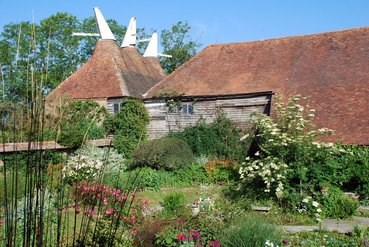 The oast used to be full of broilers, their deep litter sawdust being used as fertilizer and soil conditioner in te garden. The great barn was used by the tennant farmer who farmed the Dixter estate. In the White Barn, in what is now the ladies loo, we, the gardeners, had our morning and afternoon tea break, sitting in the semi dark. For lunch we went home, me to Garden Cottage and Don and Albert to their nearby cottages on the hill.
The oast used to be full of broilers, their deep litter sawdust being used as fertilizer and soil conditioner in te garden. The great barn was used by the tennant farmer who farmed the Dixter estate. In the White Barn, in what is now the ladies loo, we, the gardeners, had our morning and afternoon tea break, sitting in the semi dark. For lunch we went home, me to Garden Cottage and Don and Albert to their nearby cottages on the hill.
By the entrance of the garden stood a white kiosk, meant to sell tickets for house and gardens. It was designed by Quentin. It was a pretty contraption, but too small for anyone but a midget. It was never used but nevertheless carried out and put into place ceremoniously around every 1st of April.
The entry still looks the same: the old pear tree to the left, the Crataegus orientalis and the bay tree on the right. There used to be a fastigiate poplar which I called the flagpole. Fortunately that has gone. On the front lawn there was no Chusquea yet. As a matter of fact there were no bamboos at all in the garden, apart from the low running gold-variegated Arundinaria viridistriata in the Barn Garden. The Chusquea and the Arundinaria falconeri came from Alan Roger, if I remember well. The Phyllostachys came much later from Holland and were brought by me. The bedding in the Solar Garden in front of the house is the only bit of garden which has always stayed the same. Of course the bedding plants change every year, but then they always did so. The background of white Japanese anemonies and of the shrub Bupleurum fruticosum has never changed.
Follow me down the steps into the Wall Garden. In my time there was no mosaic. There was a lawn. Christo got bored with this lawn and decided he would like a mosaic. It was a birthday present from his friends, at least - the design was. “What mosaic?” , you might well ask now, as two thirds of it have diappeared: one third under an ever expanding Cistus cyprius and the other two thirds under an enormous wedding cake of potted plants arranged by Fergus.
Onwards Christian soldiers, into the Barn Garden. Here nothing stayed the same, apart from the four corner pieces of Osmanthus an the Brunswick figs trained on the White barn in the background. Forty years ago it was dominated by large shrubs and trees: countless Olearias (or should I say Olearias? We never were sure about the right pronounciation), quite a few Hydrangeas, and a lot of Fuchsias: ‘Tenessee Waltz’, ‘Mrs. Popple’, ‘Tom Thumb’are names which come floating to the surface in my mind. The were already grasses. Christo was ahead of his time, as far as ornamental grasses are concerned. No need for the Dutch Wave to hit Dixter, in later years. In the Barn garden there were three different Miscanthus, as well as two Calamagrostis (one was then still a Stipa) and the annual Briza maxima. Of all the different Olearias only Olearia solandrii remains.
We used to sell a lot of Olearias, in the nursery, and also by mail trade. Every winter we were busy packing and sending plants. A lot of Olearias we sold, until the severe winter of 1978. Most of the Olearia’s in the garden perished, but the ones we had sent out fared no better. I remember a customer from the West Country writing and describing how the postman had to wade through a yard of snow with a box full of plants. Upon opening the parcel he found that all the Olearias were dead. At Dixter not only the Olearia’s disappered. The showpiece of the Blue Garden, a huge Pittosporum, never revived in the spring. To sum up the Barn Garden as it is now: only the shape is still the same.
The Blue Garden used to be rather boring, with winter flowering Viburnums and a decrepit Prunus subhirtella. It has improved no end, in Christo’s time with the arrival of the evergreen Magnolia ‘Maryland’ and under Fergus it really has become an interesting bit of garden.
The Topiary lawn, in the ancient past used by Christo’s father to practise his putting – he was fond of playing golf – was still a lawn in my days. Now it has changed into a meadow, the topiary reminding us of its formal past. I like the lawn as a meadow, but in winter I also used to like the long shadows of the topiary on the mown and frosted grass.
The biggest change at Dixter is the disappearance of the roses from the rose garden. Now the Exotic Garden but Christo, full of glee, always insisted in calling it The Old Rose Garden. It is one of Ferguses great exploits that he realised this long cherished wish of Christo. Other head gardeners, Tom Shepherd, and me before him, could never muster up the energy to rip up the roses. W never even entertained the thought. Now a boring bit of garden has changed into an exciting jungle – at least in late summer and autumn. A great triumph.
The long border is still as long, but its character has changed, It has become more interesting with wild plants – weeds, some would say – allowed to sow themselves in amongst the cultivated plants. It is glorious in May when the cow parsley flowers together with the last tulips, and later when the wild moon daisies sow themselves everywhere. Another self sowing addition to the garden is the acid-yellow Smyrnium perfoliatum.
The orchard is no longer recognizable as an orchard, apart from the fact that the trees still stand in military order. During my time at Dixter Christo became interested in Sorbus, rowans, and decided to oust most of the old Apple trees. I loved the impressive old Bramleys and I did not enjoy grubbing out large trees my only tools being a spade an an ax. But my protests were ignored. A few trees which were real eye catchers were alowed to remain, together with the fruit trees in the upper orchard (now called the prairie) but the Great Tempest of 1987 finished those off, together with one of the mulberries above the Circular Steps.
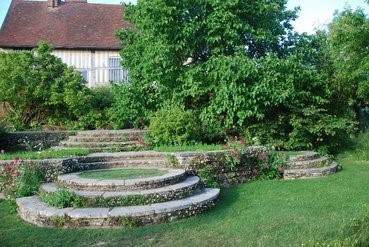 Those steps themselves look rather different, partly planted up with dwarf conifers. I am not sure whether these are a permanent feature, or meant to be counted as bedding out.
Those steps themselves look rather different, partly planted up with dwarf conifers. I am not sure whether these are a permanent feature, or meant to be counted as bedding out.
Another victory whe should attribute to Fergus is the make over of the High Garden. In my time the nursery stock was there in rows, and some plants which never did well in pots were sold as great clumps directly from the High Garden. If customers saw me coming back from there with a great clump of Gentiana acaulis, they’d often say: ‘ Oh, could I have one of those as well?’, and back I’d go again to dig up more. The High Garden is still used as a place for nursery stock but the plants are no longer in rows, but arranged in an exciting mixture.
As Christo got older, Fergus’s influence inceased. Change took place gradually, so it is not possible to distinguish a point where Fergus took over. First there was Christo, then there was the team of Christo and Fergus and after Christo’s death there was Fergus with Christo always in the back of his mind, just as Christo is still in my mind after all those years. Hardly a day passes for me without thinking of him. And some of his classic sentences, like ‘I’ll tell you when I see pencil and paper’ when people ask him the name of a plant, have become my own. After Christo’s death the garden kept on evolving, as every good garden should. We have to applaude Fergus for this, for keeping experimenting as Christo did and for not letting the garden end up as a museum. Dixter is still very much alive and kicking; I see a different garden every year within the original frame of walls and hedges.
To return to Christo: he was a talented writer, a great gardener, an excellent cook and a terrific host.
But he was no saint. He was impatient, for instance. One of my friends had a stammer. Christo did not like stammers. ‘Come on, spit it out’, he would shout as my friend stammered along and of course that made his stammer even worse.
Christo did not really get on with his brother Quentin who lived at Little Dixter (see below), given that name to distinguish the house from Great Dixter. And he did not at all get on with Quentins wife, Pam.
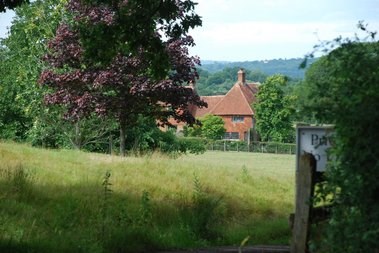
Quentin did the promotion and general managing of Dixter. He had a small office by the solar stairs, with a table full of correspondence and documents. And he wound all the clocks in the house.
Every Friday he would come and do his clock winding round. Christo would try and avoid him. He thought Quentin was lazy and they did not see eye to eye. In those days meadow gardening was not at all fashionable and sometimes visitors took one look at the long grass behind the garden gate and turn round, deciding to give the garden a miss. Others used to write to Quentin, the publicity officer, and enquire if the lawn mower had broken down recently. Or maybe the Lloyds were saving up for one? Quentin used to quote these letters to Christo and suggest that a proper English lawn at the entrance of the garden might draw more visitors. That used to infuriate Christo. Things escalated to the point where Christo only communicated with Quentin by written notes. And I was the go-between. I agreed that Quentin was lazy, but being somewhat lazy myself, I could not dislike him for that. He did not contribute much, but was no villain either. He did not have a strong character but I rather liked him. Christo was a bit too harsh in my eyes, writing him off as useless.
The sister in law, Pam, was a different matter. She used to come and pick the peaches and apricots while Christo was on holiday in Scotland. And I agree: that was theft. Perhaps she had a right to her half of the harvest, but she should have asked. The ongoing war between Great Dixter and Little Dixter came to a head when The Quentin Lloyds wanted their money out of the trust and most of the contents of the house had to be auctioned.
Christo was ruthlessly honest, and sometimes he hurt people where he could have been more diplomatic. He was loyal to his friends, but could make cutting remarks to those he disliked. And he tended to be biassed against women, although he had a lot of female friends – all strong characters of course, who stood up to him and sometimes pulled his leg.
And what about Fergus (head gardener Fergus Garrett as seen below), is he perfect? I must be careful and weigh my words as he is present. He will go down in history as the Saviour of Dixter, and this title is well earned.
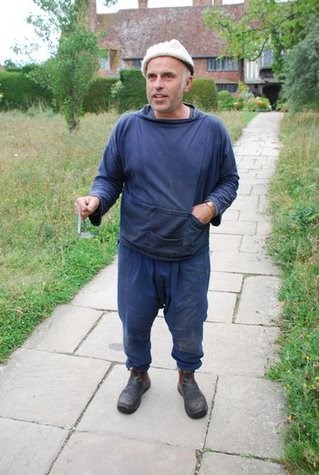
But in the Lloyd tradition let me be ruthlessly honest.
I love the way Fergus has changed Dixter, both during Christos lifetime and thereafter. I love the way plants are alowed to sow themselves everywhere, thus knitting the whole garden together.
But if you knit a garden together the separate entities of the garden start to look like one another. Is this a good thing? Or should the different parts of the garden have different characters? I often ask myself this question, but cannot come up with an answer and I would love to discuss the matter. Christo loved discussing things. ‘Nothing like a good argument’, he would often say. And I agree; the best ideas surface as the result of a discussion. Fergus is always busy. Does he have enough time for a thorough discussion? I cannot answer the question, but if I see him whizz through the garden in tearing haste, I sometimes wonder if there is often time for a relaxed discussion.
Then there is the small matter of the overgrown paths. I know Dixter was never designed to be a garden which receives 50.000, 70.000? visitors a year, but that being a fact – is it not sometimes necessary to go round with secateurs and make room for people to pass one another? And should not that Cistus in the Walled garden be culled, so that more of Christo’s dachshund mosaic becomes visible?
But these are small points, and really of no great importance. In Christo’s time there were just as many differences in point of view as in Fergus’s. What really matters is that the garden keeps on changing. Gardens should never stand still and whether I, or others for that matter, like or dislike some of these changes is not important.The great thing about Dixter is that it is still personal and that it keeps on developing. Change is natural and necessary and that is the very reason why Dixter reamains such an exiting garden.
Sometimes I am asked: ‘Do you think the garden is better now than in Christo’s time?’ It is a question I can’t answer. The question is academic and not relevant for me. All I can say is that the garden is completely different from the garden I came to 40 years ago. And that I love Dixter as it was, and also as it is. Just as I love both Christo and Fergus. Everything should change continually to remain interesting: both people and gardens. And may they continue to do so for years to come.
But this is a lecture and not a sermon and I can hear myself starting to preach. I will stop. Thank you for listening.
Great Dixter, Northiam, 29 July 2017
